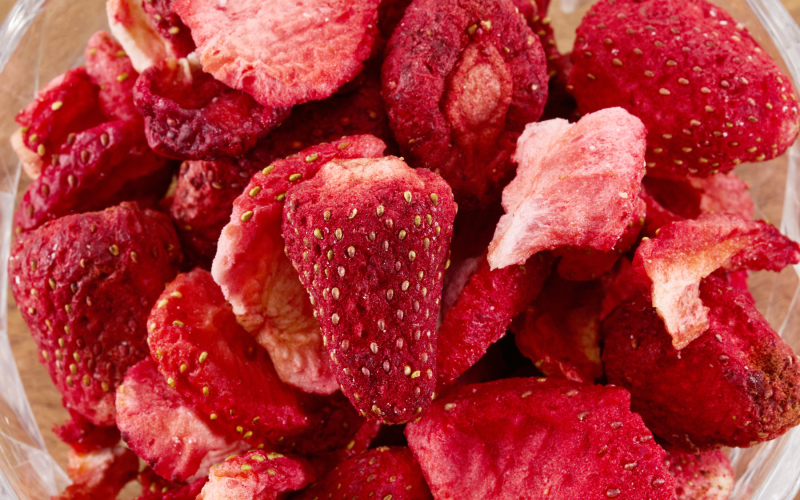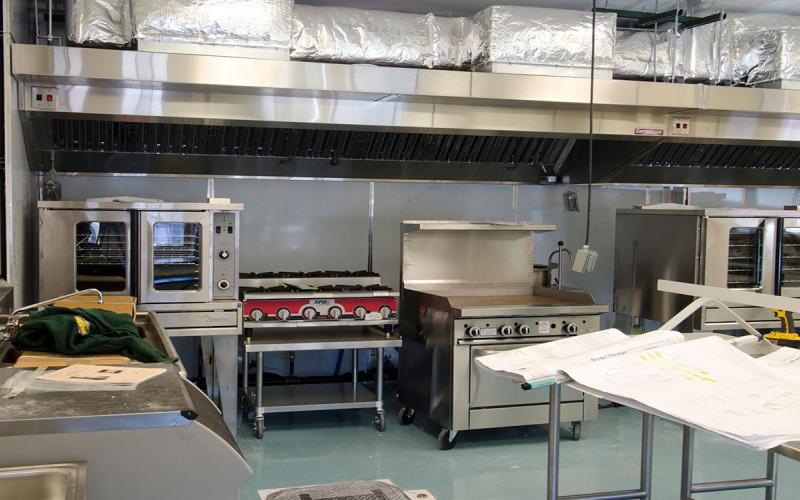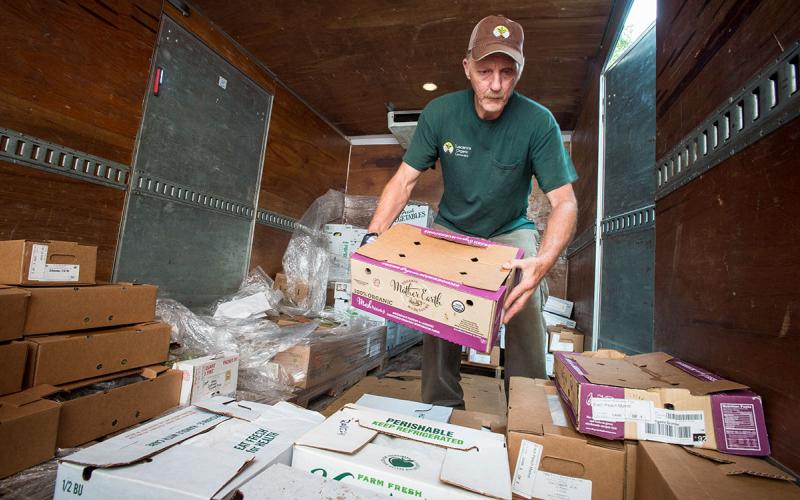Written collaboratively by Curtis Braun, Joan Hegerfeld-Baker (former SDSU Extension Food Safety Specialist), Peter Duryea (Consumer Safety Officer, USDA Food Safety & Inspection Service), and John Osburn (Health Facilities Surveyor, South Dakota Department of Health).
Poultry exemptions can be difficult to interpret. This article was developed to address some of the questions small growers may have regarding poultry exemptions for selling at the farmers market in South Dakota.
South Dakota small poultry producers (also referred to as growers) raise, slaughter and process on their farms. Besides on-farm direct marketing to the consumer, poultry growers can also sell processed poultry at farmers markets. The Poultry Products Inspection Act (PPIA) exempts from inspection certain operations.
Title 9 Code of Federal Regulations CFR 381.10 further delineates these operations. All poultry not exempted from inspection in South Dakota is inspected by the USDA.
The marketing of these poultry products to licensed and inspected foodservice facilities that prepare or market food products through a retail establishment must also meet the South Dakota Department of Health’s Foodservice Code. SD DOH allows poultry from a FSIS exempt processor to be used/served in a licensed restaurant. The license holder would need to have the PL exemption number stamped on the packaging or provide necessary documentation to verify the poultry is exempt from inspection. This publication focuses primarily on farmers markets and direct sales to consumers.
Refer to the Following Definitions When Reviewing This Information (Title 9 CFR 381.1)
- Exempt means that certain types of poultry slaughter and processing operations qualify to operate without the benefit of federal inspection, and a grant of federal inspection is not required.
- Poultry means any domesticated bird, whether live or dead, raised for human food. Ducks, geese, turkeys, chickens, guinea and pigeons are examples of amenable (subject to inspection, unless exempted) poultry. Used interchangeable with the term “bird.”
- Adulterated products bear or contain a substance that makes it injurious to health, or if it has been held, packed or produced under insanitary conditions.
- Slaughter refers to the act of killing poultry for use as human food.
- Processed or Processing refers to operations in which the carcasses of slaughtered poultry are defeathered, eviscerated, cut-up, skinned or otherwise manufactured or processed.
- Poultry product refers to any poultry carcass, or part thereof. If a food product contains other ingredients as well as poultry (for example a chicken pot pie), it is considered a food prepared with poultry products and must meet the regulatory standards of the South Dakota Foodservice Code.
- Misbranded applies to any poultry product slaughtered and processed, even if exempted by the PPIA, that is misleading or false. Several circumstances can lead to misbranding, one of them being the misuse of the official inspection legend.
A producer/grower can qualify for only one exemption from PPIA in a calendar year. The three most common exemptions for producers at farmers markets in South Dakota normally qualify for three different categories:
- Producer grower with 1,000 birds or less.
- Producer grower with 20,000 or less and greater than 1000 birds.
- Producer grower or other person (PGOP).
Produce, Slaughter and Process 1,000 Birds or Less Exemption
All of the following criteria that must be met:
- The producer slaughters and processes their own healthy poultry on their premises for human food consumption.
- The producer does not engage in buying or selling poultry products other than those raised on their farm.
- Slaughter and processing conducted under sanitary standards, practices and procedures that produce poultry products that are sound, clean and fit for human food (not adulterated).
- The producer keeps records necessary for effective enforcement of the PPIA (Title 9 CFR 381.175). The producer must keep flock, slaughter and sales records of all poultry that is sold to a customer. These records must verify that they have met all criteria and stayed under the 1000 bird limit.
- All poultry products are sold within the state, they do not move between states.
- The equipment for processing can be owned, rented or made available as a mobile unit specific for processing birds. Mobile units must be approved by the FSIS Administrator. In South Dakota contact the FSIS OFO District Office, District Manager, Room 985 Federal Bldg., 210 Walnut Street, Des Moines, IA. 50309. Office Phone: (515) 727-8960.
Produce, Slaughter and Process 20,000 Healthy Birds or Less Exemption
The producer grower must meet the following criteria:
- Slaughter and process more than 1000 and 20,000 or less birds.
- Distributed solely within the state of South Dakota.
- Slaughter and processing must occur on the producer/growers premises using sanitary standards, practices and procedures that produce poultry products that are sound, clean and fit for human consumption. The facility used to process poultry is not used to slaughter or process another person’s poultry unless the District Administrator of FSIS grants an exemption.
- Only distributes poultry products he or she produced under exemption.
- Can rent slaughter or processing equipment for their own poultry without requesting an exemption from the FSIS Administrator.
Producer Grower or Other Processor (PGOP) Exemption
This exemption refers to a single entity that could be the poultry grower that slaughters and processes for direct sale to household consumers, or purchasing live poultry from a grower to slaughter and process for direct sale to household consumers. This also qualifies for sale at farmer’s markets in South Dakota. The following criteria must be met:
- The PGOP slaughters for processing and sale directly to household consumers.
- The PGOP slaughters no more than 20,000 poultry in a calendar year that the producer/ grower or other person raised or purchased are slaughtered and processed under this exemption.
- The poultry processed by a PGOP is poultry that the PGOP slaughtered.
- Poultry products produced by the PGOP are distributed solely by the manufacturer and only within the State of South Dakota.
- The PGOP does not engage in the business of buying or selling poultry or poultry products prepared under other exemptions in the same calendar year.
- The slaughter and processing at the producer/ grower or other person’s facility is conducted in a manner that results in the preparation of poultry products that are wholesome, sound, clean and fit for human food (not adulterated).
- The facility used to slaughter and process poultry is not used to slaughter or process another person’s poultry unless the Administrator of FSIS grants an exemption [PPIA Section 464(c)(3); Title 9 CFR 381.10b)(2)].
Exemption Status
Official exemption status or approval does not need to be obtained from FSIS. However, if the poultry products are found to be adulterated, misbranded or the slaughter processor are not in compliance with criteria set forth by PPIA, the exemption to slaughter, process and sell poultry at the farmers market can be terminated by the FSIS.
Selling Producer Raised, Slaughtered and Processed Poultry and Poultry Products at Farmers Markets in South Dakota
Producers selling their own processed birds at a farmer market must comply with the exemptions of PPIA.
The term processing refers to fresh or frozen, whole or parts of raw poultry that are ready-to-cook (for example, selling bags of gizzards or dark meat). The birds must be in a frozen state to avoid the need to maintain specific temperatures. If foods are required to be temperature controlled for safety, they have to be processed or prepared in a licensed kitchen. In South Dakota home processed foods are not allowed for sale in licensed kitchens.
To freeze poultry, use food grade packaging that is of moisture/vapor proof material. If using plastic bags, they must be intended for freezer use. Remove excess air to avoid freezer burn. The faster carcasses are frozen, the better the quality and safety. If using home freezing units, chill carcass to 40°F in an ice slush bath, package and spread out in freezer allowing for air circulation. Do not overstock freezer space.
Package Labeling of Poultry Processed Under PPIA Exempt Status at Farmers Market
The following information must be on the package label* when selling poultry at farmers market in South Dakota:
- Name of Product
- Name of producer and contact information
- Date the poultry was processed
- “Processed under Exempt – P.L. 90-492”
- Net Quantity Statement: Net wt. AMOUNT lb. (AMOUNT grams or kilograms). The quantity declaration is required to be in terms of the largest whole unit of weight or measure with any remainder expressed with appropriate decimal fraction.
- Safe Handling Instructions:
- Keep refrigerated or frozen, thaw in refrigerator, microwave or cold water (cook immediately if using microwave or cold water).
- Keep raw poultry separate from other foods.
- Wash working surfaces including cutting boards, utensils and hands after touching raw poultry.
- Cook thoroughly – at least 165°F.
- Keep hot foods hot. Refrigerate leftovers immediately.
*The package label is dependent upon the form of packaging. For example, if selling three individually packaged birds that have been placed in one box, the label may be on each package or the box.
Sample label for individual packaged whole chicken:
Chicken – Whole Fryer
Processed on Jan 1, 2014
Net Wt. 4.3 lb. (2 Kg)
Processed under Exempt – P.L. 90-492
Safe Handling Instructions:
- Keep refrigerated or frozen, thaw in refrigerator, microwave or cold water (cook immediately if using microwave or cold water).
- Keep raw poultry separate from other foods.
- Wash working surfaces including cutting boards, utensils and hands after touching raw poultry.
- Cook thoroughly – at least 165°F.
- Keep hot foods hot. Refrigerate leftovers immediately.
Valley Farm / Somewhere, SD 00000 605-000-1234
Sample label for box with more than one whole chicken:
Chicken – Whole Fryers
Processed on Jan 1, 2014
Net Wt. 12.3 lb. (5.6 Kg)
3 whole chickens
Processed under Exempt – P.L. 90-492
Safe Handling Instructions:
- Keep refrigerated or frozen, thaw in refrigerator, microwave or cold water (cook immediately if using microwave or cold water).
- Keep raw poultry separate from other foods.
- Wash working surfaces including cutting boards, utensils and hands after touching raw poultry.
- Cook thoroughly – at least 165°F.
- Keep hot foods hot. Refrigerate leftovers immediately.
Valley Farm / Somewhere, SD 00000 605-000-1234
Marketing Food Products Made With Poultry Slaughtered and Processed Under PPIA Exempt Status
Food products that are prepared using poultry products that were slaughtered and processed under exemption of PPIA can be sold in licensed foodservice establishments in South Dakota. Food products (such as pizzas or pot-pies) that include poultry cannot be prepared and sold at the farmers market in South Dakota unless they were prepared in a licensed kitchen. This is due to the need for temperature controls among other critical safe food handling practices. Any deviations from the SD Foodservice Code (or this publication) would need to be addressed by the department on a case-by-case basis.
If interested in starting a licensed kitchen/foodservice establishment contact the SD Department of Health (DOH) Office of Health Protection by calling 605-773- 4945 or visiting the SD DOH Food Service Licensing website. If in the city of Sioux Falls, call 605-367-8760 or visit the Sioux Falls DOH Licensure/Permits/Registration website.
Basic Sanitary Standards: Facilities, Slaughter, and Processing
The basic sanitary standards for the slaughter and processing of poultry on the farm are summarized below. These standards are based on the regulatory requirements of what is required for a full USDA inspection (Guidance, 2006). The facilities and all aspects of the slaughter, process, handling and storage must prevent adulteration of all poultry products.
Sanitary operating conditions of food and non-food contact surfaces should be cleaned and sanitized as necessary to prevent the unsanitary conditions which can lead to an adulterated product. Use cleaning and sanitizing compounds for their intended use, they must be safe and effective.
Grounds and pest control are maintained to prevent the entry of pests, insects or animals into areas where poultry is slaughtered, processed and stored.
Sewage and waste disposal system that properly removes the feces, feathers, trash, garbage and paper from the facility. Sewage must be disposed through a separate drainage system to prevent the backup of sewage into other lines that could contaminate the slaughter, processing and handling areas.
Water supply and water, ice and solution rinse must comply with the South Dakota drinking water regulations. If using a private well, it should be tested and meet the SD drinking water regulations. The SD Department of Environment and Natural Resources oversees the drinking water regulations. Visit their website or contact via phone at 605-773-3754.
Personnel Health & Hygiene practices focus on health cleanliness of those handling the poultry through the entire process. If suffering from any of the following, the food handler should not be allowed to handle the poultry at any step of the slaughter and processing: food borne illness, diarrhea, vomiting, jaundice, sore throat, above normal temperature, live with or exposed to someone that is experiencing a food borne illness.
Personal Cleanliness is critical. Clothes should be clean, hands washed, and hair restrained. Those handling and slaughtering live birds should be kept separate from processing, unless they have changed clothing and thoroughly washed hands and forearms.
Additional Resources
The USDA Policy Development Staff in Omaha, NE can assist with answering regulatory type questions. Visit their website to submit your question.
An On-farm Poultry Processing Guidelines publication can be found at the Northeast Beginning Farmers Project website.
The South Dakota Foodservice Code along with additional resources for licensed kitchen establishments can be located at the SD Department of Health’s Food and Lodging website.
Document Sources:
- “Subpart A – Definitions.” Title 9 Code of Federal Regulations §381.1 (2004).
- “Exemptions.” United States Code Title 21 Sec. 464. (2011).
- “Exemptions for specified operations.” Title 9 Code of Federal Regulations §381.1 (1992).
- “Guidance for determining whether a poultry slaughter or processing operation is exempt from inspection requirements of the Poultry Products Inspection Act.” USDA. FSIS. Revision1. April 2006.
- “Records required to be kept.” Title 9 Code of Federal Regulations (CFR) §381.175 (1995).
- “South Dakota Department of Health Foodservice Code.” South Dakota Administrative Rules (1997).


